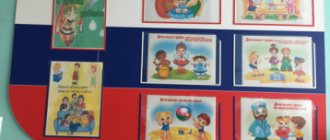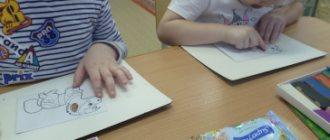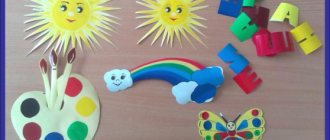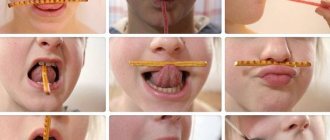Consultations for parents (legal representatives) consultation on speech therapy on the topic
Question answer
At what age is it time to show a child to a speech therapist?
The opinion that a child should be brought to see a speech therapist by the age of five is now outdated. The fact is that by this age the child’s speech has already been largely formed, and the most favorable period for speech development is the age of 2-3 years.
It is at this age that you need to ask whether everything is fine with your child’s speech. And even if the speech therapist at the clinic says that the child’s development is appropriate for his age, it is necessary to visit the speech therapy office annually to monitor the dynamics of speech formation.
After all, what is the norm at three years is already a lag at four. If the mother had problems during pregnancy or childbirth, and the child was seen by a neurologist, then in this case it is necessary to especially carefully monitor the development of speech. Then mom won’t have to hear the question so often asked by speech therapists: “Where have you been all this time?”
Can a mother herself determine whether her child needs a speech therapist?
If by the age of 2.5 years a child has not formed elementary phrasal speech, it is considered that the rate of his speech development lags behind the norm. A three-year-old child uses simple prepositions in sentences (on, in, under, for, with, from) and conjunctions because, if, when.
In the speech of a four-year-old child, there are already compound and complex sentences, the prepositions by, before, instead of, after, because of, from under, conjunctions that, where, how much are used. By this time, whistling sounds (s, z, z), s, e, and somewhat later - hissing sounds (sh, zh, ch, sch) appear. The sounds r, l usually appear by 5-5.5 years. By the age of five, the child has fully mastered everyday vocabulary and uses general concepts (“clothing,” “vegetables,” etc.). There are no longer omissions or rearrangements of sounds and syllables in words; the only exceptions are some difficult unfamiliar words (excavator, etc.).
If your child's speech differs significantly from these norms, you should contact a speech therapist. However, very often parents get used to their child’s speech and do not notice many problems in his development, especially if this child is the only one in the family.
Therefore, it is recommended to visit a speech therapist at the clinic for the first time at the age of three and then annually for preventive purposes.
If your child’s babbling has faded, and the first words have not appeared even by the age of 2, then you should seek help earlier.
Can parents correct their child’s speech themselves?
Undoubtedly, it is difficult to overestimate the role of the mother or other close people in the development of the child’s speech. Currently, a lot of books have appeared to help parents develop their child’s speech, for example Maksakov A.I. Tumakova G.A. “Learn by playing”; Fomicheva M.F. “Education of correct pronunciation in children”; Shvaiko G.S. "Games and play exercises for speech development."
Sometimes it is enough to attract the child's attention to the correct pronunciation of a sound to get a positive effect.
In other cases, it is first necessary to develop articulatory muscles with the help of articulatory gymnastics (ask a speech therapist how to perform it correctly).
However, if, despite your efforts, the child has not learned to pronounce sounds correctly within a month of lessons, it is best to turn to a professional. Further attempts to correct the pronunciation may aggravate the problem, for example, it may reinforce the child’s incorrect pronunciation or even discourage the child from studying.
Pay special attention to your own speech, because... For children aged 1 to 6 years, parents’ speech is a role model and serves as the basis for subsequent speech development.
It is important to adhere to the following rules:
- you can’t “babble” with a child, i.e. speak in a babbling language or distort sound pronunciation, imitating the speech of a child;
- it is desirable that your speech is always clear and moderate in pace;
— when communicating with a child, do not overload your speech with words difficult to pronounce for children, incomprehensible expressions, and phrases. The phrases should be fairly simple. Before reading a book or fairy tale, new, unfamiliar words found in the text must not only be explained to the child in a form understandable to him, but also illustrated: look at a bright picture, go on an excursion, etc.
— a child should not be punished for mistakes in speech, imitated or corrected irritably.
It is useful to read age-appropriate poetic texts to children.
How to get to classes with a speech therapist?
If you decide to see a speech therapist, you must first go to the clinic. The clinic's speech therapist advises parents on speech development, conducts clinical examinations of children in kindergartens and schools, and corrects simple speech disorders in children of all ages. He also refers the child, in case of more pronounced disorders, to a psychological, medical and pedagogical commission (PMPC) to clarify the diagnosis and, if necessary, place the child in a specialized group of the kindergarten. In kindergarten, a speech therapist works only with children enrolled in his group.
What does a speech therapist do?
Contrary to popular belief, a speech therapist does not only “produce” sounds. The work of a speech therapist in a correctional group begins with the development in children of attention, visual and auditory perception (recognition and discrimination), memory and thinking. Without this, it is impossible to establish a full-fledged educational process. The tasks of a speech therapist include expanding and enriching children’s vocabulary, correcting grammatical errors and teaching literacy.
A speech therapist helped my older child in six sessions, so is it worth going to a speech therapy group?
Speech impairment can only be expressed in incorrect pronunciation of sounds (dyslalia or FFN). In this case, it is enough to contact a speech therapist at the clinic. The process of speech correction for such a disorder can take from one month to a year, depending on the number of incorrectly pronounced sounds and the individual characteristics of the child. With general speech underdevelopment (GSD), not only sounds are impaired (sometimes up to 16 or more).
The syllabic structure of the words is broken: “peter” - now, “masalet” - airplane, “agat” - grapes. The vocabulary is poor, verbal substitutions are often allowed: helmet - “hat”, bottom - “sole”, saw - “knife”. The child has difficulty constructing a phrase, often with grammatical errors.
Correction of such speech disorders is possible only with daily complex medical and pedagogical intervention in a specialized group and can take up to 2-3 years or more.
Will my child become “like everyone else”?
Parents often ask whether the child will be able to correct all existing violations. The result of correctional work depends on many factors: the severity of the violations, the presence of concomitant diseases, the timeliness of assistance and the regularity of classes, the complexity of the impact, the interest of the child and parents in correcting the violations. In many cases, the correction process takes more than one year and requires a lot of patience from all participants in the process. Children with developmental disorders certainly need qualified assistance from a correctional teacher. But no less they need adequate help from their parents. In the absence of sufficiently effective and early diagnosis of the child’s development, it is the parents who, suspecting a delay or disturbance in the child’s development, should seek help from specialists and actively get involved in the work themselves. After all, no one can approach a child better than mom and dad, and no one is more interested in the final result.
The child's medical record contains a diagnosis of RRD. What is this?
A diagnosis of “speech development delay” (SSD) means that the child’s speech development is slower than expected. This may be due to hereditary reasons (father or mother also started talking late), or frequent illnesses of the child. In this case, all the body’s forces are spent on fighting the disease, and not on development, including speech. Speech development can also be delayed if the child does not talk or read much. Radio and television do not help the formation of speech. At the initial stages of speech development, the child must not only hear speech, but also see the articulation of the adult. Speech should be simple, clear and accessible. If speech development delay is due to these reasons, specialist intervention is not required. It is enough to create favorable conditions for the child’s development.
However, it happens that delayed speech development is caused by harmful influences during pregnancy, childbirth or in the first years of a child’s life (stress, infections, injuries and much more), which parents are sometimes unaware of. In this case, speech development is not only delayed, but also disrupted. It is no longer possible to do without medical and pedagogical assistance.
ZRR is usually given to children under 3-3.5 years of age. After this age, and sometimes earlier, if the child’s speech still does not correspond to the age norm, we can speak not of delayed, but of impaired speech development. In this case, you need to contact a neurologist and speech therapist.
How to properly teach a child to read and write?
The basis of learning to read is not the letter, but the sound. Before showing your child a new letter, for example M, you should teach him to find the sound [m] by ear in syllables and words. At first, you should name both the sounds and the letters corresponding to them the same way - [m], [b], and not em or be. Saying this, we pronounce two sounds - [e] and [m]. This only confuses children.
Another serious mistake is in letter-by-letter reading, that is, the child first names the letters: MA - and only after that adds the syllable itself: MA. This skill of incorrect reading is very persistent and is corrected with great difficulty. Even if a child can read words of three or four letters in this way, reading more complex words will be impossible. Correct reading is reading in syllables (until fluent reading is formed). At first, let the child draw out the first letter of the syllable for a long time until he recognizes the next letter.
The main thing is that he does not stop after the first letter and reads the letters of the syllable together. First of all, children are taught to read syllables like AP, UT, IK, etc. Then they move on to syllables like MA, NO, VU. After the skill of reading syllables is sufficiently automated, they move on to reading words like MAC, MOON, STICK, etc. according to increasing complexity of words. If in oral speech a child replaces some sounds, for example [Ш] with [S] (“sapka”) or [R] with [L] (“lyba”), it is not recommended to teach him the corresponding letters until the sound pronunciation is completely corrected . Otherwise, the child may form an incorrect connection between the sound and the letter representing it.
Before teaching a child to write, it is necessary to develop a correct grip on the pen. A lot of kids do it wrong. The child’s hands should lie on the table so that the elbow of the right hand (for right-handed people) protrudes slightly beyond the edge of the table, and the hand moves freely along the line, while the left hand lies on the table and holds the sheet.
The handle is placed on the upper part of the middle finger, and the nail phalanges of the thumb and index fingers hold it at a distance of 1.5–2 cm from the end of the rod. Teach your child to navigate on a sheet of paper: show the upper right, lower left corner, middle of the sheet, etc. Then they are taught to see the lines, find the beginning and end of the line.
How to help a child
what if he forgets, confuses, or writes letters incorrectly?
If a child writes letters in the wrong direction (mirrored) and confuses the arrangement of letter elements, this is most often a consequence of unformed spatial representations. Check if your child can show his right ear, left leg, etc. correctly.
Game-activities such as “Tangram”, “Pythagoras”, “Fold a square”, and various “constructors” are very useful. It happens that a child confuses letters that are completely different in spelling: M and B, T and D. The reason for this may be that the child has difficulty distinguishing the corresponding sounds by ear. At the same time, his physical hearing may be absolutely normal. Teach your child to listen for difficult sounds in syllables and words. To make it easier for your child to remember letters, the following techniques are recommended:
— Coloring letters, shading;
— A child sculpting letters from plasticine.
— A child cutting out letters according to a contour drawn by an adult.
- “Writing” with broad gestures all the letters being studied in the air.
- Comparison of the letter and its elements with familiar objects, other letters: the letter U - bunny ears, etc.
— Tracing a letter cut from fine sandpaper or velvet paper with your finger, recognizing letters by touch with your eyes closed.
— Laying out letters from various materials: braid, buttons, matches, etc.
— A child tracing letters written by an adult.
- Writing letters using reference points set by adults.
Is it possible for my child to stutter?
Approximately 2% of children stutter, i.e. one in fifty. Moreover, stuttering occurs four times more often in boys than in girls. Stuttering usually occurs between 2 and 5 years of age. Very often, parents blame fear, illness, or other stress as the cause.
In fact, many children are afraid of animals or other things, but they do not stutter. Consequently, the real reason is the weakening of the child’s central nervous system, and fear served only as a trigger. Stuttering can be provoked by a sudden change for the worse in the family situation or regime.
There are frequent cases of stuttering in children with precocious speech, whose parents read them too many poems, fairy tales, make constant requests: “tell me”, “repeat”, and often force them to speak for show.
One of the common causes of stuttering in children is an excessive speech load (repetition of incomprehensible and difficult words; recitation of poems that are complex in content and large in volume; memorizing fairy tales and stories that are not appropriate for the age and development of the child). Sometimes in children who started speaking late (at the age of about three years), stuttering occurs simultaneously with the rapid development of speech. Stuttering can also appear in children with slow developing motor skills.
Such children are awkward, do not look after themselves well, chew sluggishly, and their fine motor skills (strength, dexterity, mobility of the hand and fingers) are not well developed.
Such children are not recommended to watch a lot of TV, especially at night.
You should not overload your child with a large number of impressions (cinema, reading, watching TV, etc.) during the period of recovery after an illness. Failure to comply with the regime and requirements of proper education at this time can easily lead to stuttering.
You cannot intimidate or punish a child by leaving him alone in a room, especially a dark one. Before going to bed, it is better to play quiet, calm games. Do not try to get an answer from a child when he is crying, sobbing convulsively. This can cause stuttering. Calm him down first.
Stuttering can sometimes occur by imitation if someone around the child stutters.
In order to help the child in time, it is very important not to miss the first signs of stuttering: the child suddenly suddenly becomes silent, refuses to speak (this can last from two hours to a day, after which the child begins to speak again, but stuttering); the use of extra sounds (a, and) before individual words; repetition of the first syllables or whole words at the beginning of a phrase; forced stops in the middle of a word or phrase; difficulties before speaking.
When the first signs of stuttering occur, you should contact a neuropsychiatrist.
Speech therapy corner as part of a subject-development environment in a preschool group
In preschool age, a very pressing problem is the problem of speech in all its diversity. There are many techniques that allow you to regulate the process of speech development in children. The most important condition for improving the speech activity of preschoolers is the creation of an emotionally favorable situation that promotes the desire to actively participate in verbal communication.
The development of a preschool child is greatly influenced by the space around him, the environment in which he spends most of the time. A subject-based developmental environment makes it possible to enrich the experience of a child’s emotional and practical interaction with peers and the teacher, and to include all children in groups in active cognitive activity. The subject-development environment includes a correctional corner in the group. It is a specially equipped space for playing alone or in small groups. Its equipment includes shelving, a mirror, gaming, didactic and visual material. With their help, educators create conditions for correcting deviations in the development of children, stimulating speech activity and verbal communication. The content is determined not by chance, but in strict accordance with the program, physiological and psychological-pedagogical features of speech formation.
Didactic equipment must correspond to the structure of children’s speech disorders, their individual and age characteristics. Only with this approach is it possible to effectively correct the speech of preschool children. An integral attribute of the speech corner should be a toy - an “animate character” that helps solve such important correctional problems as overcoming uncertainty, shyness, achieving emotional stability, self-regulation, arousing speech interest in children, and encouraging speech activity.
It is advisable to locate the correction corner in a well-lit place and somewhat distant from the playing area. This will create more comfortable conditions for studying there. Access to the corner should be convenient so that children can approach it themselves and study. If there is insufficient lighting, additional lighting must be provided.
The occupancy of the speech therapy corner in groups is carried out according to sections:
‒ articulation gymnastics in pictures: (pictures for articulation exercises, sets of exercises for articulation in pictures-tables).
- fine motor skills: tops, dry pool, lacing, stencils, etc.;
- breathing: pinwheels, pipes, balloons, bubbles, air flow games, etc.;
‒ phonemic awareness: games for differentiating sounds
‒ sound pronunciation: albums on sound automation, game exercises, games on sound automation: “Speech therapy lotto”, etc.
‒ vocabulary: pictures reflecting the lexical topic being studied (plot and subject); educational puzzles, games: lotto, “Pick a Pair”, “Who Can Name More”, “Part and Whole”, etc.;
‒ grammatical structure of speech: games “Whose tail?”, “One is many”, “Call it affectionately”, “What’s missing?” and etc.;
‒ coherent speech: plot pictures, “Guess by the description”, “When does this happen?”, “We play in the profession”, etc.;
‒ literacy: diagrams of words, sentences, games: “Match a word to a diagram”, “Make a sentence according to a diagram”, “Add a word”, etc.
Game and didactic material is replaced and replenished in the correctional corner weekly, depending on the lexical topic. It is necessary to diversify the activities of children in the correctional corner. Didactic equipment must meet the needs of the child’s current, immediate development and self-development. You should not overload the corner with equipment, as this makes selection difficult. But it is necessary to take into account that even an empty subject space tires and encourages idleness and aggression. Relying on play as the leading activity of preschoolers provides teachers with a significant positive effect in correctional work.
The selection of gaming and didactic material is carried out jointly by the speech therapist and the teacher, which makes their interaction not formal, but very close and fruitful. The material contained in the correction corner should be multifunctional, making it possible to use it for different purposes.
When creating a group correctional corner, it is very important that the environment surrounding the children is comfortable and aesthetically pleasing. Its design should be attractive to children and arouse their desire for independent activity. At the same time, it is necessary to teach children to maintain order in the corner and cultivate a caring attitude towards toys.
Thus, the use of a correctional corner allows you to expand the speech environment in the group, create in children emotional responsiveness and a desire to participate in verbal communication with adults and independently, during the game, easily and naturally develop and improve their speech skills.
Literature:
- Artamonova O. V. Subject-spatial environment: its role in personality development // Preschool education.-2005-No. 4
- Konovalenko V.V. Corrective work of a teacher in a preparatory speech therapy group - St. Petersburg, GNOM and D, 2009.
- Nishcheva N.V. Subject-spatial developmental environment in kindergarten, N.V. Noscheva.-St. Petersburg: Childhood-Press, 2006.
- Stepanova O. A. Organization of speech therapy work in preschool educational institutions.-M., 2007.







